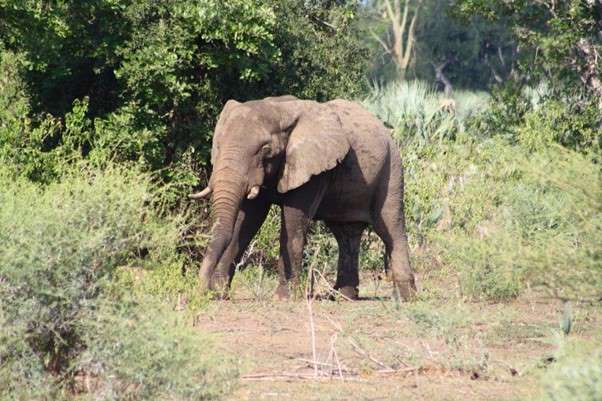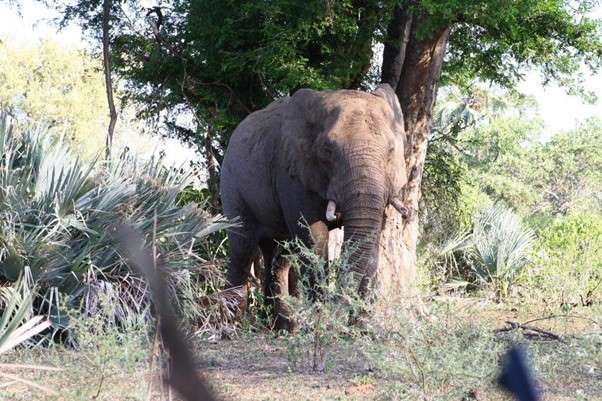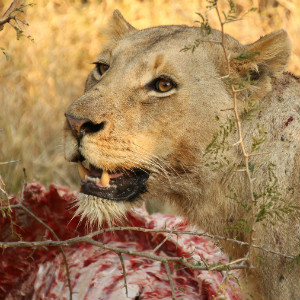Safari guide Rhodes Bezuidenhout of Shangani Trails recounts a trip with clients to the Makuleke concession in Kruger National Park when they came face to face with a bull elephant in musth.
Always expect the unexpected when on safari
When on foot in Big Five country, sometimes circumstances dictate events no matter how many precautions one takes. Such was the case of a walk I undertook with students from the University of Cornwall in the UK while instructing with EcoTraining in the Makuleke Concession, Kruger National Park.
With the heat of the day behind us, we headed out of camp into the floodplain past Lala Palm windmill with the intention of a short loop into the fever tree forest. Not far past the windmill, Norman Chauke, my co-instructor, hissed in my ear.
‘Elephant!’
Elephant indeed, a lone bull slowly making his way towards us but still some way off. Cameras whirred as the first sighting of these magnificent animals was enjoyed by all.

The bull moved slowly into the shade of a large nyala berry reaching up to feed off the lower branches. His ears moving rhythmically creating airflow across the numerous veins at the back of the ears to cool the blood. This would in turn would reduce its body temperature as it flows back through to the heart.
Approaching the elephant on foot
Feeling the wind in our favour as well as the afternoon sunlight behind us, I suggested to the group we make an approach on foot to view the bull at closer quarters. With the Group needing no persuasion, we conducted a quiet safety brief discussing our approach and the do’s and don’ts.
Confirming the wind direction and the sun’s position, I led the group in a loop to approach the elephant from the west eventually finding the shade of a large apple leaf tree about 40 metres from the bull.
We sat down in the shade and watched him as he continued to reach up into the lower branches of the nyala berry to feed. He then turned his attention to a lala palm thicket enjoying the white pulpy flesh at its base rather than the rough sharp fronds.
With a clear view of the front of bull’s head and shoulders, it was obvious he had just enjoyed a shower at the nearby water trough, the dampness showing up clearly against the dry patches.

With cameras working overtime, we saw the bull finally clear the nyala berry and lala palm thicket before slowly turning towards our position and ambling in our direction.
Realisation the elephant was in musth
The tension rose tangibly behind Norman and I, as the big bull drew nearer. As he closed to 15m, Norman and I had our first full view of his entire profile, seeing the tell-tale dripping mucous from his penis, confirming he was in musth.
With the bull still unaware of our presence, I whispered to the group not to move and be as quiet as possible. I raised myself to a kneeling position and softly spoke to the bull thus making him aware that we were in front of him.

He looked at us quizzically for a moment, his eyes still soft, before shaking his head with just a hint of irritation and moving off to our left behind another lala palm thicket.
I wasted no time in requesting Norman to lead the group out to the safety of a nearby nyala berry while I stayed behind to monitor the bull.
He was, however, in no mood to hang around and have a conversation. He slowly made his way in the opposite direction towards the open floodplain and the fever trees beyond. Once re-grouped, everyone broke into excited chatter about the encounter. Another amazing experience for the group, fresh out of Heathrow to view a large elephant bull at such close quarters on their first day.
Discover more
To find out more about musth in elephants check out our complete guide to musth which includes video, photos and frequently asked questions.
This article was written by Rhodes Bezuidenhout of Shangani Trails. To find out what a tailor made walking safari could be like drop Rhodes a line. His email contact details can be found on his blog profile.
The Makuleke concession in northern Kruger is truly one of very few remaining wilderness-bastions where the pace of life is still naturally intact and warrants preservation. The lack of traffic in the area makes it a wonderful location for walking safaris.
If you are interested in Makuleke please check out the following blog articles: The magical wetlands of Makuleke and The elephants of Makuleke.
The elephant is one of the Big Five. To find out the other four animals that make up the Big Five please check out our article: 25 astonishing facts about Africa’s Big 5

 Previous Post
Previous Post



